In the Yoast SEO plugin, you’ll find a focus keyphrase input field for every page on your site. Here, you can enter the keyword or keyphrase you’d like the page to rank for in Google. If you do, Yoast SEO will run a check on the content of that page to see if search engines will recognize what your page is about. Here, we’ll explain what the purpose of a focus keyphrase is and how to choose it well.
Looking for keyphrase suggestions? When you’ve set a focus keyword in Yoast SEO, you can now click on ‘Get related keyphrases’ and our SEMrush integration will help you find high-performing keyphrases!
What is a focus keyword?
The focus keyword or keyphrase is the search term that you want a page or post to rank for most. When people search for that phrase, they should find you. If you set a focus keyphrase for a page with Yoast SEO, the plugin evaluates the page’s content and provides feedback on how to improve the content to increase the chances of ranking higher for that search term.
You’ll find the input field for your focus keyphrase in the Yoast SEO sidebar on the right side of your editor. If you don’t see the Yoast SEO sidebar, click on the Yoast icon on the top right of your screen first.
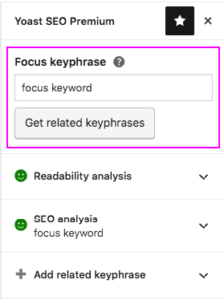
You can also find the focus keyphrase input field in the Yoast SEO meta box below the post editor:
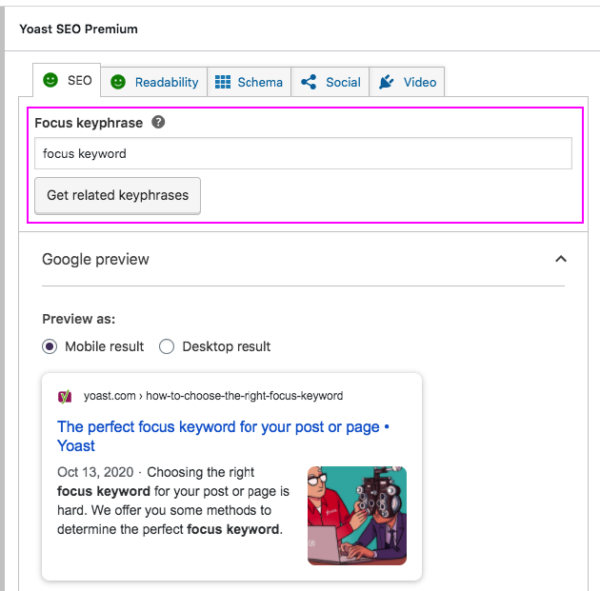
You’ll find the feedback to improve your content in the SEO analysis tab. If you amend your page with this feedback, it will be easier for search engines to recognize what your post or page is about.
Check out this video to see how it works:
Why a focus keyphrase?
Regularly adding quality content to your website or blog is a good SEO strategy. Google sees that your website is active because you add new information and you increase the volume of your content.
But randomly adding content to your site isn’t very useful. You have to craft a keyword strategy, and based on that strategy you should create high-quality content your audience is looking for. When you write those articles, it’s important to optimize them for the keyphrases you’re aiming at. And that’s what Yoast SEO helps you with.
How to choose a focus keyphrase
In our view, there are at least three things you should do to determine which keywords or keyphrases you should optimize your blog posts for:
- Find a focus keyword people search for
- Research the search volume
- Google your keyphrase
Let’s elaborate on these steps a bit:
1. Find a focus keyword people search for
As mentioned above, your keyword strategy should have given you some idea of what you want to write about. If you don’t have a keyword strategy yet, you should really create one. You can read our ultimate guide to keyword research or take our keyword research training course if you need help to find your perfect keywords and keyphrases.
Long-tail keywords
If you want a post or page to rank, you can increase your chance of success by aiming for long-tail keywords. Long-tail keywords often exist of more words and are less searched for than very popular ‘head’ keywords. But less popular also means less competition and the chances to convert are usually higher as you can read in this guide to content SEO.
Tools that help you find long-tail and related keyphrases
When you’ve done your keyword research and you already have an idea of what you want to write about, you can use different tools to find long-tail variants of that keyphrase or related keyphrases. For instance, you can use a tool like Answer the Public to find which questions people have about a particular topic. This will give you loads of new insights and inspiration for new posts.
But, since Yoast SEO 15.1 we’ve made this even easier for you! In the Yoast SEO plugin, we now offer a brand new feature: a SEMrush integration to easily find related keyphrases that people search for. So, when you know what to write about you can click on ‘Get related keyphrases’ below your focus keyphrase and find out what terms people search for and even learn more about volume and trends:
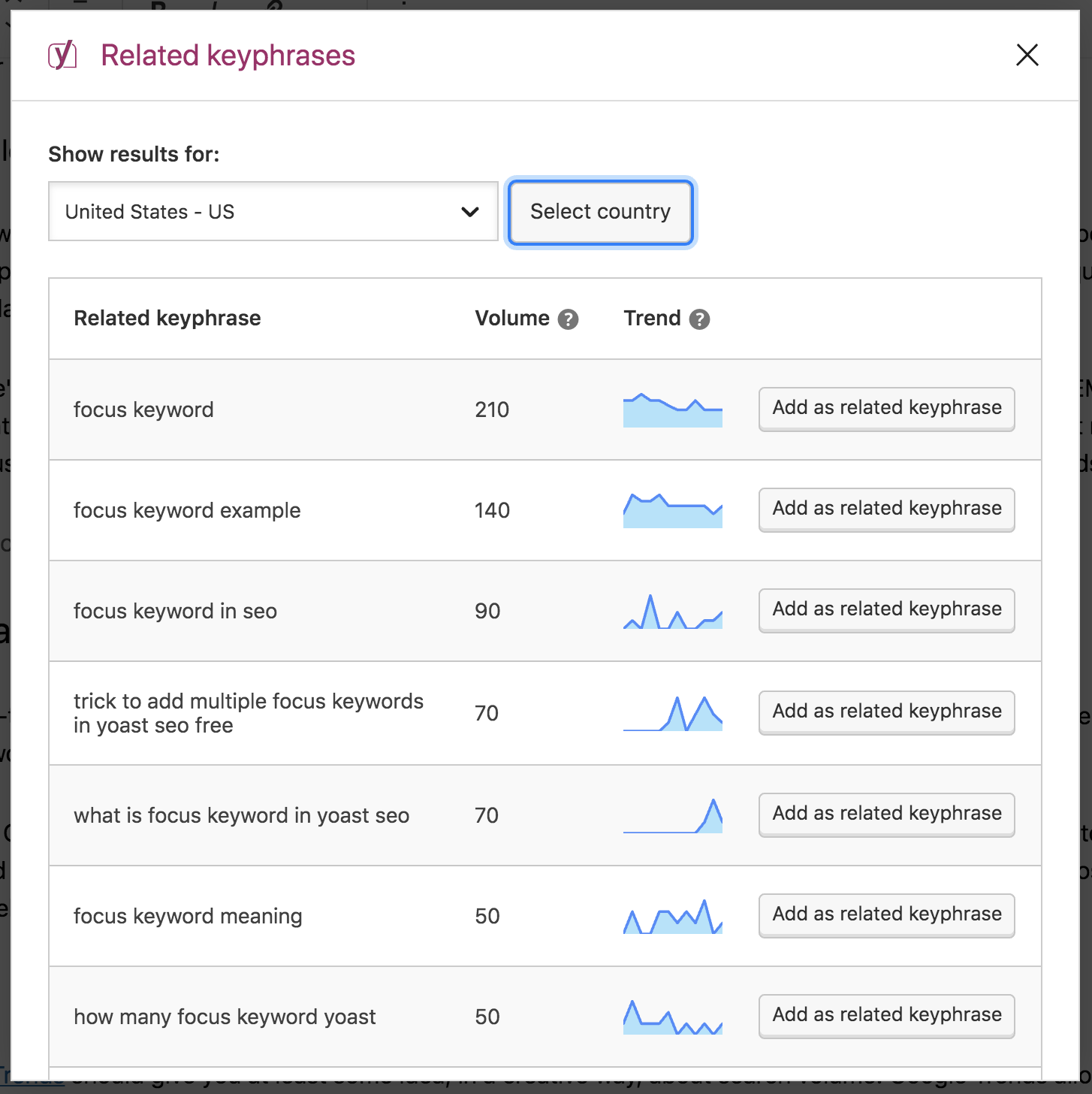
2. Research the search volume for your keyphrase
Once you have found a long-tail search term you want to rank for, you should put some effort into discovering whether or not there are many searches for that keyword or phrase – the search volume. This use to require quite some effort: researching search terms in Google Adwords or Google Trends. But now you can easily get related or long-tail keyphrases in Yoast SEO and find information about search volume (how often it is searched for in a specified period of time) and trends (how that changed over time) too! Now you can easily compare the possible related keyphrases and decide on which ones to focus in your current or other posts!
Optimizing your post for related keyphrases can improve the quality of your content: it will make it more complete and easier to understand for Google. If you want to set one of these related keyphrases for your posts you can do so with one click in Yoast SEO Premium. After that, go back to the post editor and optimize your post for the new related keyphrase.

In addition to setting related keyphrases and synonyms, Yoast SEO Premium better recognizes your keyphrase when it’s in plural or past tense, for instance. Google is smart, get an analysis that’s just as smart!
Check your posts that already rank
If you already have some (blog) posts that rank well for good terms, you will know how many visitors these posts attract. Using Google Trends to compare the focus keyphrases of older posts (which you can view the statistics for) with the focus keyphrase you have in mind for your new post, could give you some idea about the potential traffic this new keyphrase could bring. Make sure to choose older posts that are most similar to the post you’re planning to write: if you’re planning to choose a long-tail keyword, compare posts with long-tail keywords as well.
For instance, this post about the focus keyphrase could be compared with a post about snippet previews, a related feature of the Yoast SEO plugin we already wrote about:
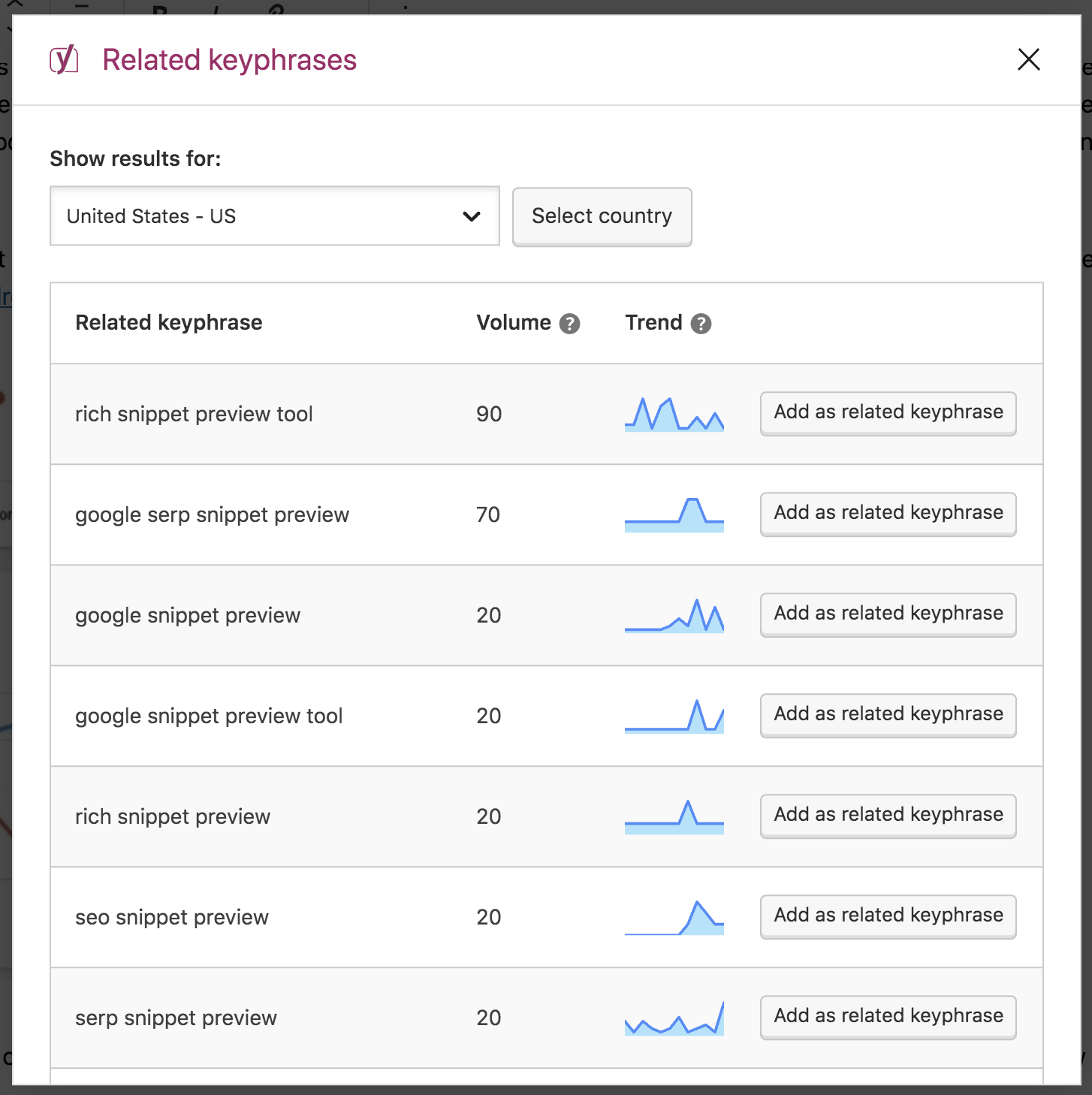
As you can see the amount of traffic is a bit lower but comparable, we know the search traffic to our snippet preview post is reasonably good, so we know it’s worth optimizing for. Doing this to compare your old focus keyphrase or keyword and the one you want to use will give you some insights about the prospects for your focus keyphrase.
Another good way to use this is when you are considering a number of (long-tail) focus keywords. Because it will easily show you which search term will have the highest search volume compared to another. Therefore, it will help you decide which long-tail keyword is most commonly used in search.
For additional tools, see this post by Marieke about keyword research tools.
3. Google your proposed focus keyword!
Apart from knowing which search terms are actually used by people, you need to know whether or not your idea for your post or page fits the needs and expectations of the people who use these search terms. You need to find out what the search intent is. One way to find out whether your content meets people’s needs is to Google your proposed (sets of) keywords yourself.
Check the search engine result pages
Take the time to look at the search engine result pages (SERPs) Are the articles in the Google results of similar character to your article? Could your article fit the results shown in these search pages? If you decide to write your blog post or page, while optimizing for this exact focus keyword, you are aiming to get your post amongst these results.
The type of content shown on the search results will help you decide on what kind of content to create: does Google show product pages or blog posts? Or perhaps videos, images? If there’s one dominant type, Google probably “thinks” this is the type of content people are looking for, so it’s worth investing time in creating that type of content too. Of course, the results change when the search intent change. Remember: you’ll have to beat the other search results, so only do this when you’re sure you can create something truly outstanding and useful for your audience!
Content of the results pages
Be sure to use the content of the result pages as an inspiration for your blog post. Are there any useful ideas? We are NOT encouraging you to copy content, merely to see whether you perhaps missed some information or arguments for your post or page. And, most importantly: How can you make sure your post will stand out? In what way could your post be better, funnier, more original than the post presently displayed in the result pages? Try to come up with content that will make the audience click and share!
Check out social media and forums
Another great tip: Check what people ask and have to say about this topic on social media and various online forums. This will probably give you loads of input for your post or page. You can directly address the questions people have and the difficulties they encounter regarding this topic. On top of this, it will help you use the right wording, which is crucial if you want to reach your audience.
Don’t forget to repeat your research now and then!
Remember that these search suggestions change all the time. The suggestions will often be tuned to what you’ve been searching for before. When we searched for the term “focus keyword” some time ago, this was the suggest output:

Later on, the output showed this:

Suggest changes based on the problems people have, so monitoring it for important keywords makes sense. New results can give you input for your post or other, but related posts.
Yoast SEO checks the quality of your keyphrase
A good focus keyword for your post is essential if it needs to stand a chance in the search engines. Therefore Yoast SEO checks some aspects of your keyphrase. First of all, we check the length of your keyphrase, to make sure your keyphrase isn’t too long. In addition to this, Yoast SEO checks whether the keyphrase only consists of function words.
The function word check in Yoast SEO
Function words (words such as the, a, and, or, have) carry very little meaning. They don’t help Google figure out the topic of the copy. We warn you if you only have words like these in your keyphrase. Even though it’s not very likely to come up with such a keyphrase yourself, it can happen that you were distracted while typing in your keyphrase. For instance, you could have just typed [the] instead of [the best movies of 2020]. To prevent keeping your focus keyphrase like this, Yoast SEO will show a warning with a grey bullet in the SEO analysis of your post and help you stay focused!
In rare cases, you might actually mean to rank for a phrase that consists of function words only. For instance, if you are writing a post about a meme “Why would you do that?”. In exceptional cases like this, you can avoid getting a red bullet by adding a double quote before and after your keyphrase. Doing so, our tool will just look for the exact match of this phrase and the warning will disappear.
Read more about the function word check in Yoast SEO.
Should every page have a focus keyphrase?
People often ask us whether their about page or contact page should have a focus keyword, and, if so, what should it be?
The answer is easy: not every page needs a focus keyword. Your contact page should be easily reachable, it might, for instance, need to rank for “<company name> address.” That probably doesn’t make sense as a focus keyword though, and it’s perfectly fine to leave it empty.
Also, ask yourself: Do I want this post to rank in the long term? Some posts, for instance, temporary announcements, are probably not worth optimizing either.
Conclusion and further readings
Choosing a perfect focus keyword or keyphrase is not an exact science. You should aim for a combination of words that are actually used by a search audience. Aim for a keyphrase that is relatively high in volume and one that will suit your audience.
We have lots more articles on this subject: you can read about keyword research, content writing and improving your site structure. We’ve also combined all of these different topics into an SEO copywriting course.
Read more: SEO copywriting: the ultimate guide »
The post How to choose the right focus keyword appeared first on Yoast.

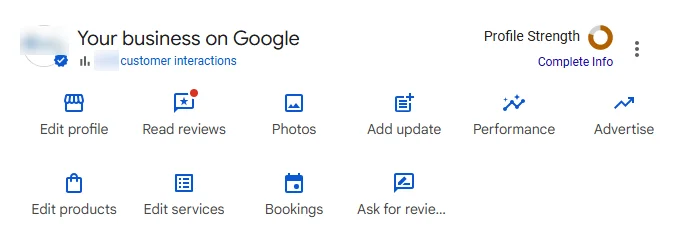

Recent Comments